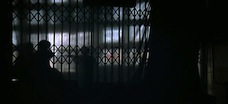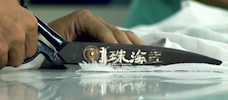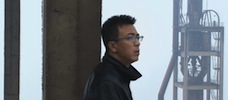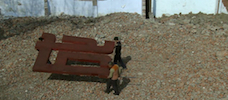Reviews
Wuyong
Jia Zhangke
China / Hong Kong, 2007
Credits
Review by Leo Goldsmith
Posted on 27 May 2011
Source Memento Films DigiBeta
Categories Jia Zhangke’s Migrations
Jia Zhangke’s neorealist cinema often leans towards or even incorporates certain forms of documentary, so it was perhaps only a matter of time before Jia set out to make one in earnest. His style, growing out of his early practice of on-location, budget-free shooting, seeks out those narratives often ignored or suppressed by state-run media in China (as they are, incidentally, in the United States), the textures and patterns of everyday life, the doldrums of labor and leisure in a changing, but no less restrictive society. Even in Jia’s narrative work, passers-by wander through the frame and stare back at the camera, a sharp contrast to the carefully composed and flattened compositions of the preceding generation’s large-scale, more mythic conceptions of historical China—films like those of Zhang Yimou, whose opening ceremony for the 2008 Summer Olympics in Beijing might be said to be an epic of distraction.
Still, it was not until after his 2006 feature, Still Life - itself partly a record of the spectacularly destabilizing Three Gorges Dam Project - that Jia took up the documentary mode explicitly. Many of his contemporaries, like Wu Wenguang and Zhang Yuan, had been fully engaged in the practice of low-budget digital-video documentary cinema for a full decade and a half, so in some sense Jia came late to a trend that was becoming increasingly appealing, if not vital to the international film festival circuit. And yet, his choice of subject matter was telling: proposing a trilogy of documentaries about artists working in contemporary China, Jia avoided his contemporaries’ cinéma vérité style, inspired by Frederick Wiseman and Shinsuke Ogawa, and direct engagement with social issues in favor of a more oblique approach. Characteristically, his documentaries - first Dong, about the painter Liu Xiaodong, then Useless, about the fashion designer Ma Ke - would retain an equivocal mix of the banal and the surreal, extending a style that plays upon the encroachment of fantasy and popular culture into the everyday lives of working-class Chinese.
Much like The World and Still Life, Useless is an ideologically slippery film, ambiguously provoking questions about a number of socially relevant issues without explicitly addressing any one of them. Even its origins as a commissioned work for the designer Ma Ke herself and her new haute couture fashion line, Wu yong, or Useless, hint at a strange compromise similar to the one Jia has struck with the officials of the Chinese Film Bureau. As if to answer these doubts, Jia begins his film with a sequence inside a sweat-shop in Guangdong. It’s not exactly an exposé - Jia and his cinematographer Yu Likwai certainly had enough access to compose the beautifully langorous, gliding tracking-shots that are their trademark - but the sequence immediately gives a face to the most notorious aspect of China’s garment industry.
For many years, Mainland China has been by far the largest exporter of apparel in the world; by 2007, something like half of the world’s clothing was manufactured there. The vast majority of this industry is based in factories like the one with which Jia introduces Useless, the South China Garment Industry Building, complete with its Mao-era architecture, rows upon rows of sewing machines, and semi-regimental cafeteria. In a nod to the Lumières’ Workers Leaving the Factory - if not to Harun Farocki’s film on the same subject - factory workers are here seen squeezing through or climbing over locked gates to escape, presumably, for lunch or a smoke. It’s an oddly metaphorical image of the peculiar strictures of factory life in China, made still more eerie by the wordlessness of the soundtrack: all we hear are the mechanical crunch of the machines, the hum of overhead fluorescents, and the whirr of the occasional fan—until Jia, with deeper irony, fills the soundtrack with the romantic strains of a corny pop song.
This first sequence contains gestures towards a more vérité style: a visit to the cramped single-room clinic finds one worker awkwardly complaining of fatigue symptoms, while another naps in the background. Other shots of the factory floor suggest what might have been more of a process film about clothing production. But Jia’s intention is to set up his “main subject”: Ma Ke and her new fashion line Useless. The clothing we see being manufactured in this prologue is in fact for Ma’s first venture in fashion, a line called Exception for the company Mix Mind. (Jia gives us a shot of the Mix Mind store in Guangzhou as a transition.) And while Ma, sitting for an interview, does not disavow her earlier venture, she obliquely rejects the cheaply made clothing flooding the market in favor of her new haute couture line: “We set out to create something different, unconventional.”
For Ma, the artisanal, handmade alternative that she proposes is a way of reinvesting fashion with emotion, with a more personal connection: “With industrial products, there’s no link between the maker and the user; you don’t know who made your clothes.” Wuyong, she suggests, is a deliberate attempt to create “useless” products—that is objects that, even when broken would retain their life, their story, would not be simply disposable. “Objects carry memories,” Ma asserts, and she describes her design process of burying clothing so that they would be “imbued” with the place and time of their making. While neither Jia nor Ma telegraph their point, it’s clear that this practice is a direct rejection of the kind of mass production seen at the start of the film, the manufacture of identical products whose labels of “Made in China” seem actually to mask more than reveal details about the geographic specificity of their origins, or about labor conditions and individual lives of those who manufacture them.
These sorts of clothes, Ma says, have no place in a materialist society, although the film is remains somewhat ambiguous on this point. Jia cuts from Ma’s studio to shots of another Guangzhou department store where young upper-class women sip red wine and discuss the distinctiveness of Paul Smith, Prada, Louis Vuitton, Christian Dior. Ma’s line may stand in contrast to much of the disposable, mass-produced clothing that comes out of China, but Jia subtly suggests that it has attained a new use-value as a luxury brand, and the film somewhat seductively elides this point with a quick excursion to Paris Fashion Week, where French models disrobe and don Ma’s carefully soiled and pre-worn clothes. (These include something that looks like an enormous down coat that engulfs one of the models—a totally impractical, but strangely industrial-looking object that must weigh ten pounds.)
Lingering deferentially on the warm applause that greets Ma Ke’s Fashion Week debut, Jia then dissolves coyly to the acid-orange factory landscape of Shanxi province, Jia’s home county, in Northern China. Driving through this area in an SUV, Ma notes that, while visiting such remote places, one feels like one is “recovering a lost memory.” But Jia is quickly distracted: his camera lingers on an itinerant, shabbily dressed man by the side of the road - very much a “lost memory” in contrast to the Parisian models - and follows him into a small town. Here, Jia takes up a number of tiny narratives that will occupy him for the rest of the film’s duration: a local seamstress and her drunken husband bicker and glance furtively at the camera; boys ride shirtless on motorcycles, yelping and squawking and chasing after one another; another couple - a former tailor and his wife - sit for a similarly furtive interview with Jia, who asks innocently, “So, why did you choose those clothes?”
The former tailor, we learn, had to give up his business to work in the coal mines, the largest industry in the area. He explains that the ever-cheaper clothing available means that the work of a tailor is itself rendered useless: why pay a yuan - roughly fifteen cents — to have your suit fixed when you can buy a brand new one, ready to wear, for the same price? Soon, Jia takes us on an excursion into the mines, where we observe - in arch contrast to the boney models of Paris Fashion Week - a shower-room full of coalminers, their bodies naked and blackened, hosing themselves down after a shift. A slow track reveals their clothing, helmets, boots, and overalls, crumpled together and covered with soot, casually tossed aside as the miners bathe.
From the factories and port cities of Guangdong to the fashion-runways of Paris and back to the coal-mining towns of Shanxi, Useless wends a strangely wayward path through the subject of fashion, its variable functionality and material presence in the everyday lives of subjects with a range of economic backgrounds. In this way, the film may seem an unusual entry in his planned trilogy about artists working in contemporary China, a trilogy that Jia has yet to finish. But in exploring another form of creative practice and production, the film also hints at Jia’s ideas about his own work as a filmmaker and about cinema’s similarly ambiguous mix of social function and commercial imperative. The film leaves us with the image of yet another tailor in a small Shanxi town, this one scraping by with small jobs and waiting for the proposed demolition of his shop by the local authorities. Thousands of miles from Paris, he is taciturn and uncomplaining as he sets about his work, operating his foot-cranked sewing machine, which Jia’s camera lingers on, observing patiently and without comment.
More Jia Zhangke’s Migrations
-

Xiao Wu
1998 -

Unknown Pleasures
2002 -

The World
2004 -

Useless
2007 -

Still Life
2006 -

Dong
2006 -

24 City
2008
We don’t do comments anymore, but you may contact us here or find us on Twitter or Facebook.



